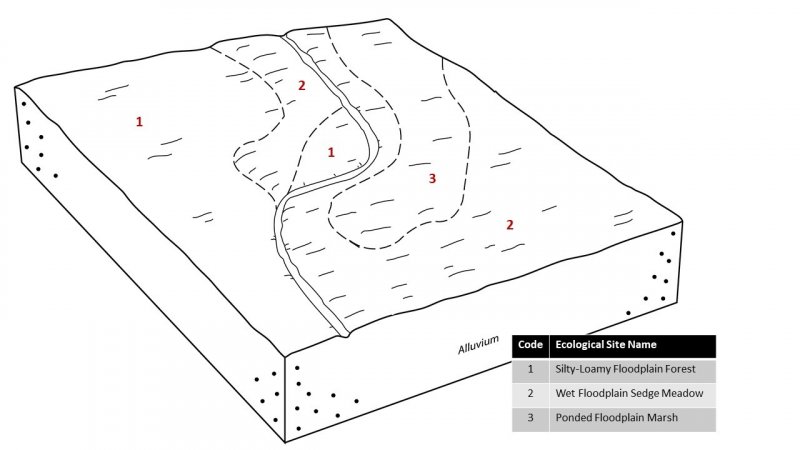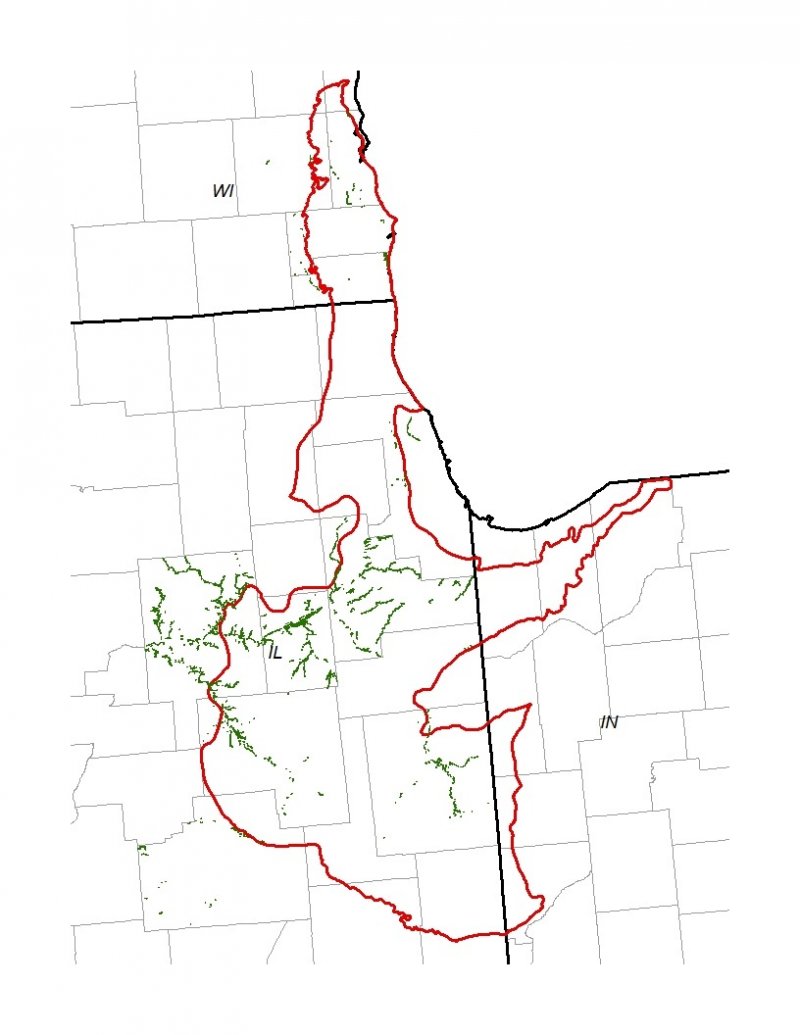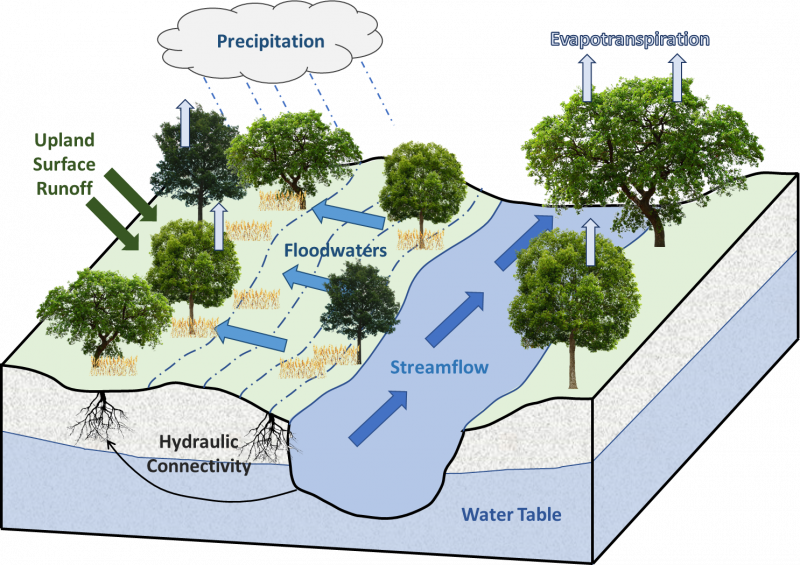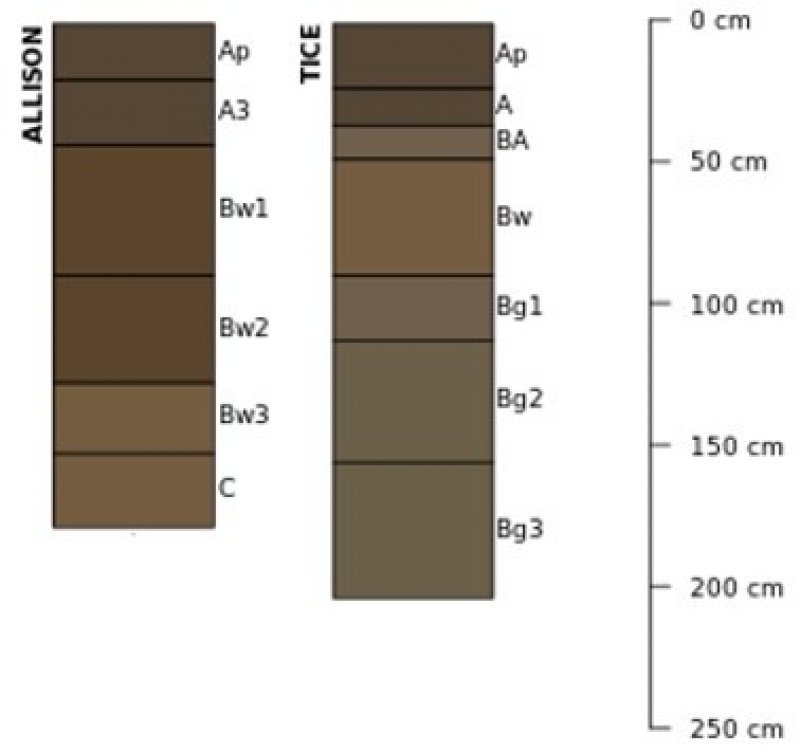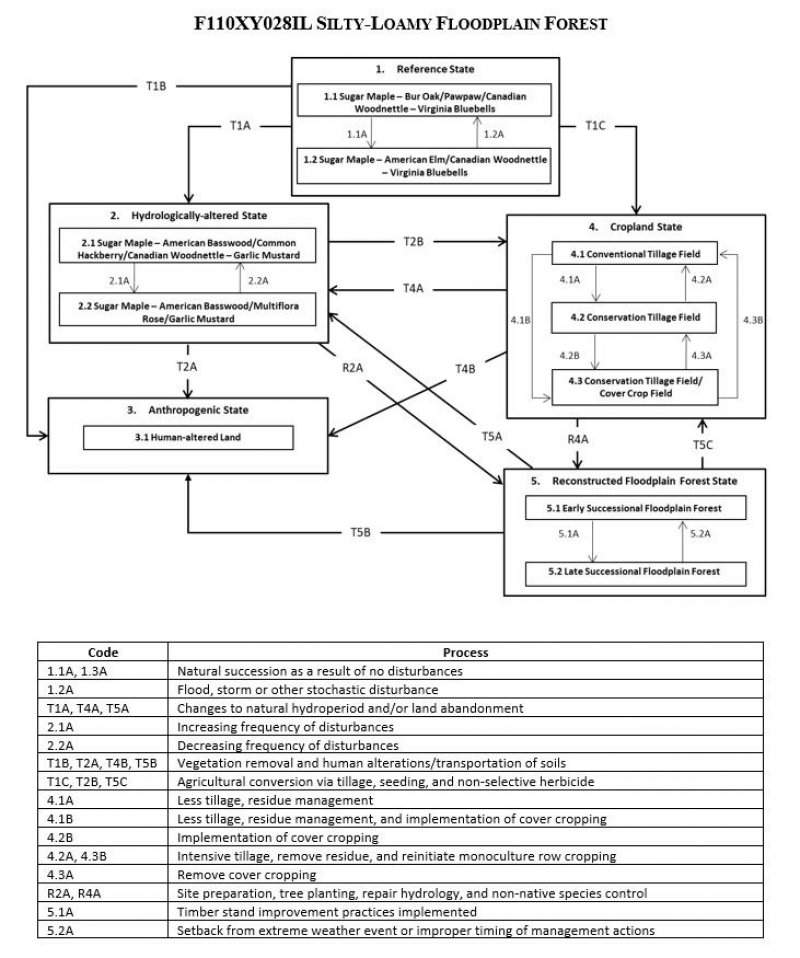Ecological dynamics
The information in this Ecological Site Description, including the state-and-transition model (STM), was developed based on historical data, current field data, professional experience, and a review of the scientific literature. As a result, all possible scenarios or plant species may not be included. Key indicator plant species, disturbances, and ecological processes are described to inform land management decisions.
The MLRA lies within the tallgrass prairie ecosystem of the Midwest, but a variety of environmental and edaphic factors resulted in landscape that historically supported prairies, savannas, forests, and various wetlands. Silty-Loamy Floodplain Forests form an aspect of this vegetative continuum. This ecological site occurs on floodplains on somewhat poorly to well drained soils. Species characteristic of this ecological site consist of upland and hydrophytic woody and herbaceous vegetation.
Rare to occasional flooding is the dominant disturbance factor in Silty-Loamy Floodplain Forests, and storm damage and pests are secondary disturbances. Seasonal flooding occurs every two to twenty years, and flooding can persist for up to seven days at a time. Damage to trees from wind storms can vary from minor, patchy effects of individual trees to stand effects that temporarily affect community structure and species richness and diversity (Irland 2000; Peterson 2000). Trees are susceptible to a variety of pests (e.g., insects, fungi, cankers, wilts), therefore periodic insect and disease outbreaks play an important role in local canopy structure.
Today, many Silty-Loamy Floodplain Forests have been reduced as a result of conversion to agricultural or other human-modified lands. Remnant sites have been degraded due to significant changes to the natural hydrologic regime and diminished water quality in the watershed. A return to the historic plant community may not be possible due to significant hydrologic and water quality changes in the watershed, but long-term conservation agriculture or habitat reconstruction efforts can help to restore some natural diversity and ecological function. The state-and-transition model that follows provides a detailed description of each state, community phase, pathway, and transition. This model is based on available experimental research, field observations, literature reviews, professional consensus, and interpretations.
State 1
Reference State
The reference plant community is categorized as a floodplain forest community, dominated by woody and herbaceous vegetation tolerant of periodic flooding. The two community phases within the reference state are dependent on a regular flood regime. The amount and duration of flooding alters species composition, cover, and extent. Periodic pest outbreaks and windstorms have more localized impacts in the reference phases, but do contribute to overall species composition, diversity, cover, and productivity.
Community 1.1
Sugar Maple - Bur Oak/Pawpaw/Canadian Woodnettle - Virginia Bluebells
Sites in this reference community phase are a closed canopy forest (80 to 100 percent cover), defined by a mixture of trees. Sugar maple, bur oak, American elm, white oak, and American basswood are common trees on the site (White and Madany 1978). Trees are large (21 to 33-inch DBH) and range in height from 30 to over 80 feet tall (LANDFIRE 2009). Canadian woodnettle and Virginia bluebells are dominant species of the herbaceous layer, but other species can include Canadian wildginger (Asarum canadense L.), cutleaf toothwort (Cardamine concatenata (Michx.) Sw.), and white fawnlily (Erythronium albidum Nutt.). Shrubs, such as pawpaw, may be present where light conditions allow. Rare to occasional flooding every 2 to 20 years will maintain this phase, but an extended period of no disturbances will shift the community to phase 1.2.
Community 1.2
Sugar Maple - American Elm/Canadian Woodnettle - Virginia Bluebells
This reference community phase represents plant community succession. Mature trees are still present, but the canopy dominance shifts as the shade-intolerant species become less prominent. Shrubs are greatly reduced from the fully closed canopy, but the herbaceous layer is maintained. A major flood, atmospheric or other stochastic disturbance event will site to shift back to phase 1.1.
Pathway 1.1A
Community 1.1 to 1.2
Natural succession as a result of no disturbances.
Pathway 1.2A
Community 1.2 to 1.1
Flood, storm, or other stochastic disturbance event.
State 2
Hydrologically-Altered State
Agricultural tile drainage, stream channelization, and levee construction in hydrologically connected waters have drastically changed the natural hydrologic regime of Silty-Loamy Floodplain Forests. In addition, increased amounts of precipitation and intensity have amplified flooding events (Pryor et al. 2014). This has resulted in a type conversion from the species-rich forest to a ruderal floodplain forest state. In addition, exotic species have encroached and continuously spread, reducing native diversity and ecosystem stability.
Community 2.1
Sugar Maple - American Basswood/Common Hackberry/Canadian Woodnettle - Garlic Mustard
This community phase represents a transition in plant community composition as a result of an altered hydrologic regime. Sugar maple and American basswood become the dominant tree canopy species. Common hackberry, honeylocust (Gleditsia triacanthos L.), and boxelder (Acer negundo L.) are dominant subcanopy species. The herbaceous layer is nearly continuous but lacking in diversity. Canadian woodnettle remains a common native species, and garlic mustard (Alliaria petiolata (M. Bieb.) Cavara & Grande) can be a frequently encountered non-native species.
Community 2.2
Sugar Maple - American Basswood/Multiflora Rose/Garlic Mustard
This community phase represents persisting changes to the natural hydrology of the watershed. The overstory canopy continues to shift as the common hackberry component matures, co-dominating with sugar maple and American basswood. Non-native invasive shrubs – such as multiflora rose (Rosa multiflora Thunb.) and Tartarian honeysuckle (Lonicera tatarica L.) – become prominent. The understory may continue to be invaded by more non-native species as a result of the frequent disturbances.
Pathway 2.1A
Community 2.1 to 2.2
Increasing frequency of disturbances.
Pathway 2.2A
Community 2.2 to 2.1
Decreasing frequency of disturbances.
State 3
Anthropogenic State
The anthropogenic state occurs when the reference state is cleared and developed by human use and inhabitation, such as for commercial and housing developments, landfills, parks, golf courses, cemeteries, earthen spoils, etc. The native vegetation has been removed and soils have either been altered in place (e.g. cemeteries) or transported from one location to another (e.g. housing developments). Most of the soils in this state have 50 to 100 cm of overburden on top of the natural soil. This natural material can be determined by observing a buried surface horizon or the unaltered subsoil, till, or lacustrine parent materials. This state is generally considered permanent.
Community 3.1
Human-altered land
Sites in this community phase have had the native plant community removed and soils heavily re-worked in support of human development projects.
State 4
Cropland State
The continuous use of tillage, row-crop planting, and chemicals (i.e., herbicides, fertilizers, etc.) has effectively eliminated the reference community and many of its natural ecological functions in favor of crop production. Corn and soybeans are the dominant crops for the site, and common wheat (Triticum aestivum L.) and alfalfa (Medicago sativa L.) may be rotated periodically. These areas are likely to remain in crop production for the foreseeable future.
Community 4.1
Conventional Tillage Field
Sites in this community phase typically consist of monoculture row-cropping maintained by conventional tillage practices. They are cropped in either continuous corn or corn-soybean rotations. The frequent use of deep tillage, low crop diversity, and bare soil conditions during the non-growing season negatively impacts soil health. Under these practices, soil aggregation is reduced or destroyed, soil organic matter is reduced, erosion and runoff are increased, and infiltration is decreased, which can ultimately lead to undesirable changes in the hydrology of the watershed (Tomer et al. 2005).
Community 4.2
Conservation Tillage Field
This community phase is characterized by rotational crop production that utilizes various conservation tillage methods to promote soil health and reduce erosion. Conservation tillage methods include strip-till, ridge-till, vertical-till, or no-till planting systems. Strip-till keeps seedbed preparation to narrow bands less than one-third the width of the row where crop residue and soil consolidation are left undisturbed in-between seedbed areas. Strip-till planting may be completed in the fall and nutrient application either occurs simultaneously or at the time of planting. Ridge-till uses specialized equipment to create ridges in the seedbed and vegetative residue is left on the surface in between the ridges. Weeds are controlled with herbicides and/or cultivation, seedbed ridges are rebuilt during cultivation, and soils are left undisturbed from harvest to planting. Vertical-till systems employ machinery that lightly tills the soil and cuts up crop residue, mixing some of the residue into the top few inches of the soil while leaving a large portion on the surface. No-till management is the most conservative, disturbing soils only at the time of planting and fertilizer application. Compared to conventional tillage systems, conservation tillage methods can improve soil ecosystem function by reducing soil erosion, increasing organic matter and water availability, improving water quality, and reducing soil compaction.
Community 4.3
Conservation Tillage Field/Alternative Crop Field
This community phase applies conservation tillage methods as described above as well as adds cover crop practices. Cover crops typically include nitrogen-fixing species (e.g., legumes), small grains (e.g., rye, wheat, oats), or forage covers (e.g., turnips, radishes, rapeseed). The addition of cover crops not only adds plant diversity but also promotes soil health by reducing soil erosion, limiting nitrogen leaching, suppressing weeds, increasing soil organic matter, and improving the overall soil ecosystem. In the case of small grain cover crops, surface cover and water infiltration are increased, while forage covers can be used to graze livestock or support local wildlife. Of the three community phases for this state, this phase promotes the greatest soil sustainability and improves ecological functioning within a cropland system.
Pathway 4.1A
Community 4.1 to 4.2
Tillage operations are greatly reduced, crop rotation occurs on a regular interval, and crop residue remains on the soil surface.
Pathway 4.1B
Community 4.1 to 4.3
Tillage operations are greatly reduced or eliminated, crop rotation occurs on a regular interval, crop residue remains on the soil surface, and cover crops are planted following crop harvest.
Pathway 4.2A
Community 4.2 to 4.1
Intensive tillage is utilized, and monoculture row-cropping is established.
Pathway 4.2B
Community 4.2 to 4.3
Cover crops are implemented to minimize soil erosion.
Pathway 4.3B
Community 4.3 to 4.1
Intensive tillage is utilized, cover crop practices are abandoned, monoculture row-cropping is established, and crop rotation is reduced or eliminated.
Pathway 4.3A
Community 4.3 to 4.2
Cover crop practices are abandoned.
State 5
Reconstructed Floodplain Forest State
The combination of natural and anthropogenic disturbances occurring today has resulted in numerous ecosystem health issues, and restoration back to the historic reference state may not be possible. Many natural forest communities are being stressed by non-native diseases and pests, habitat fragmentation, permanent changes in hydrologic regimes, and overabundant deer populations on top of naturally occurring disturbances (severe weather and native pests) (IFDC 2018). However, these habitats provide multiple ecosystem services including carbon sequestration; clean air and water; soil conservation; biodiversity support; wildlife habitat; as well as a variety of cultural activities (e.g., hiking, hunting) (Millennium Ecosystem Assessment 2005; IFDC 2018). Therefore, conservation of floodplain forests should still be pursued. Habitat reconstructions are an important tool for repairing natural ecological functioning and providing habitat protection for numerous species of Silty-Loamy Floodplain Forests. Therefore, ecological restoration should aim to aid the recovery of degraded, damaged, or destroyed ecosystems. A successful restoration will have the ability to structurally and functionally sustain itself, demonstrate resilience to the ranges of stress and disturbance, and create and maintain positive biotic and abiotic interactions (SER 2002). The reconstructed floodplain forest state is the result of a long-term commitment involving a multi-step, adaptive management process.
Community 5.1
Early Successional Reconstructed Forest
This community phase represents the early community assembly from forest reconstruction. It is highly dependent on the current condition of the site based on past and current land management actions, invasive species, and proximity to land populated with non-native pests and diseases. Therefore, no two sites will have the same early successional composition. Technical forestry assistance should be sought to develop suitable conservation management plans.
Community 5.2
Late Successional Reconstructed Forest
Appropriately timed management practices (e.g. forest stand improvement, continuing integrated pest management) applied to the early successional community phase can help increase the stand maturity, pushing the site into a late successional community phase over time. A late successional reconstructed forest will have an uneven-aged, closed canopy, and a well-developed understory.
Pathway 5.1A
Community 5.1 to 5.2
Application of stand improvement practices in line with a developed management plan.
Pathway 5.2A
Community 5.2 to 5.1
Reconstruction experiences a setback from extreme weather event or improper timing of management actions.
Transition T1A
State 1 to 2
Altered hydrology throughout the watershed transitions the site to the hydrologically-altered state (2).
Transition T1B
State 1 to 3
Vegetation removal and human alterations/transportation of soils transitions the site to the anthropogenic state (3).
Transition T1C
State 1 to 4
Woody species removal, tillage, seeding of agricultural crops, and non-selective herbicide transition the site to the cropland state (4).
Transition T2A
State 2 to 3
Vegetation removal and human alterations/transportation of soils transitions the site to the anthropogenic state (3).
Transition T2B
State 2 to 4
Woody species removal, tillage, seeding of agricultural crops, and non-selective herbicide transition the site to the cropland state (4).
Restoration pathway R2A
State 2 to 5
Site preparation, tree planting, timber stand improvement, non-native species control, and water control structures installed to improve and regulate hydrology transition this site to the reconstructed floodplain forest state (5).
Transition T4A
State 4 to 2
Land abandonment transitions the site to the hydrologically-altered state (2).
Transition T4B
State 4 to 3
Vegetation removal and human alterations/transportation of soils transitions the site to the anthropogenic state (3).
Restoration pathway R4A
State 4 to 5
Site preparation, tree planting, timber stand improvement, non-native species control, and water control structures installed to improve and regulate hydrology transition this site to the reconstructed floodplain forest state (5).
Transition T5A
State 5 to 2
Removal of water control structures and unmanaged invasive species populations transition this site to the hydrologically-altered state (2).
Transition T5B
State 5 to 3
Vegetation removal and human alterations/transportation of soils transitions the site to the anthropogenic state (3).
Transition T5C
State 5 to 4
Tree removal, tillage, seeding of agricultural crops, and non-selective herbicide transition this site to the cropland state (4).

